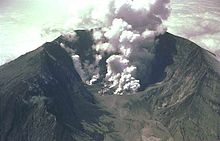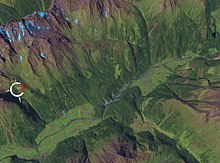Sturzstrom

A Sturzstrom (from the German Sturz (fall) and Strom (stream, flow)) or rock avalanche is a large
lava flows. They flow across land fairly easily, and their mobility increases when volume increases.[2][3] They have been found on other bodies in the Solar System, including the Moon, Mars, Venus, Io, Callisto, Iapetus,[4][5] and Phobos
.
Movement

Sturzstroms may be triggered, similarly to other types of landslides, by
acoustic fluidization theory, hypothesizes that vibrations caused by the collisions among the rock fragments reduce friction and allow the mass to travel great distances.[8] Another theory involves air pockets forming under the slide and providing a cushion that the slide rides over with very low friction, although the merit of this theory has been called into question by the presence of sturzstroms in vacuums such as on the Moon and Phobos. Observation of slides on Iapetus suggests that tiny contact points between bits of ice debris may heat up considerably during the movement, causing melting and forming a more fluid – and thus less friction-limited – mass of material.[5]

The amount of energy in a sturzstrom is much higher than in a typical landslide. Once moving, it can ride over nearly any terrain and will cover much more horizontal ground than downward-sloped ground. Its
Tyrol, Austria, deposits of fused rocks, called "frictionite" (or "impactite", or "hyalomylonite"), were found in the landslide debris. This has been hypothesized to be volcanic in origin or the result of a meteorite impact, but the leading hypothesis is that it was due to the large amount of internal friction. Friction between static and moving rocks can create enough heat to fuse rocks to form frictionite.[11][12]
See also
Wikimedia Commons has media related to Sturzstrom.
References
- ISBN 978-90-481-8699-0, retrieved 2018-06-21
- ISSN 0094-8276.
- PMID 24595169.
- doi:10.1038/ngeo1526.
- ^ a b Palmer, Jason (29 July 2012). "Saturn moon Iapetus' huge landslides stir intrigue". BBC News. Retrieved 2012-07-29.
- ^ Ivy-Ochs S, Heuberger H, Kubik PW, Kerschner H, Bonani G, Frank M, and Schlüchter C. (1998). The age of the Köfels event – relative, 14C, and cosmogenic isotope dating of an early Holocene landslide in the central Alps (Tyrol, Austria). Zeitschrift für Gletscherkunde und Glazialgeologie, (34):57–70.
- ^ Kurt Nicolussi, Christoph Spötlb, Andrea Thurnera, Paula J. Reimer (2015). Precise radiocarbon dating of the giant Köfels landslide (Eastern Alps, Austria), Geomorphology, Volume 243, August 2015, pp. 87–91
- S2CID 6215996.
- .
Sturzstroms can move along a flat course for unexpectedly large distances and may surge upward by the power of their momentum.
- S2CID 133681894.
- S2CID 129570220.
- .
